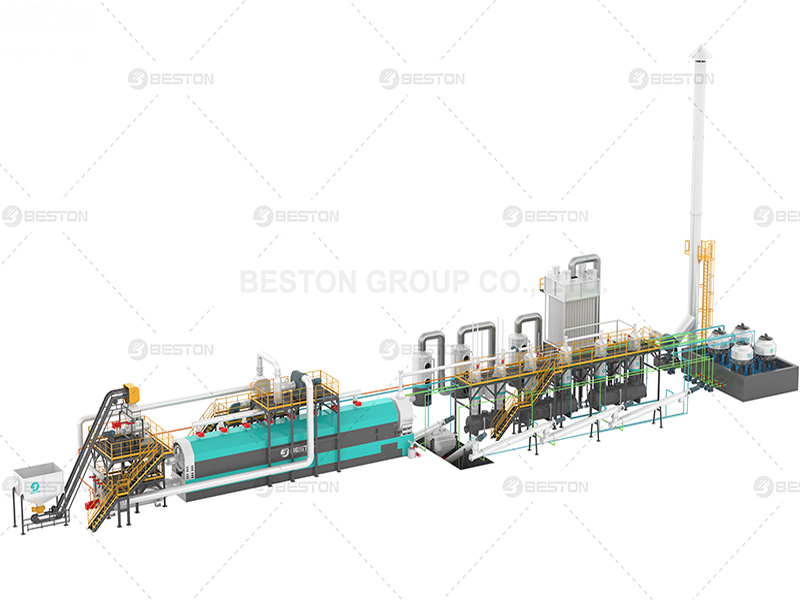The Hazards of Improper Disposal of Waste Tires
The improper disposal of waste tires poses significant environmental and health hazards. Each year, millions of tires are discarded, contributing to growing landfills and environmental degradation. When not managed properly, waste tires can lead to severe consequences, impacting ecosystems, human health, and the economy. Utilizing advanced technologies such as the waste tyre pyrolysis machine can mitigate these hazards by converting waste tires into valuable resources.
Environmental Hazards
Soil and Water Contamination
Discarded tires often end up in landfills or illegal dump sites. Over time, the breakdown of tires releases harmful chemicals and heavy metals, such as lead and cadmium, into the soil and groundwater. These contaminants can leach into nearby water bodies, affecting aquatic ecosystems and potentially entering the human food chain. The persistent nature of these pollutants makes remediation efforts challenging and costly.
Air Pollution
Burning waste tires is a common disposal method in many regions, often due to its perceived simplicity and cost-effectiveness. However, this practice releases a cocktail of toxic substances into the atmosphere, including:
- Polycyclic Aromatic Hydrocarbons (PAHs): Known carcinogens that pose significant health risks.
- Volatile Organic Compounds (VOCs): Contribute to the formation of ground-level ozone and smog.
- Particulate Matter (PM): Fine particles that can penetrate deep into the lungs, causing respiratory and cardiovascular diseases.
These pollutants degrade air quality and have far-reaching health implications for nearby communities.
Fire Hazards
Piles of waste tires are highly flammable and can ignite easily, often leading to uncontrollable fires that burn for extended periods. Tire fires produce dense, black smoke containing toxic chemicals that can cause respiratory issues and other health problems. Additionally, the runoff from firefighting efforts can contaminate soil and water, further exacerbating environmental damage.
Health Hazards
Vector-borne Diseases
Improperly disposed tires create ideal breeding grounds for disease-carrying vectors, particularly mosquitoes. Stagnant water accumulated in tires provides a perfect habitat for mosquitoes to lay eggs, leading to increased incidences of diseases such as:
- Dengue Fever
- Zika Virus
- West Nile Virus
The proliferation of these vectors poses a public health risk, especially in regions lacking adequate mosquito control measures.
Direct Human Exposure
People living near tire dumps are at risk of direct exposure to harmful chemicals and pollutants. Inhalation of toxic fumes from burning tires can lead to respiratory issues, skin irritation, and long-term health problems, including cancer. Children and the elderly are particularly vulnerable to these health hazards.
Economic Impact
Cost of Cleanup and Remediation
The financial burden of managing waste tire disposal is substantial. Governments and municipalities often bear the cost of cleanup and remediation efforts, which can divert funds from other essential services. Illegal dumping sites require significant resources to clean up, including labor, equipment, and disposal fees. Moreover, the environmental damage caused by improper tire disposal necessitates long-term remediation efforts, further straining public budgets.
Loss of Valuable Resources
Improper disposal of waste tires represents a missed opportunity for resource recovery. Waste tires contain valuable materials such as rubber, steel, and fiber that can be repurposed or recycled. By not utilizing technologies like the waste tyre pyrolysis machine, these materials are lost, contributing to resource depletion and increased demand for raw materials.

Waste Tyre Pyrolysis: A Sustainable Solution
What is Pyrolysis?
Pyrolysis is a thermochemical process that involves the decomposition of organic materials at high temperatures in the absence of oxygen. A waste tyre pyrolysis machine converts waste tires into useful products such as:
- Pyrolysis Oil: Can be used as industrial fuel or refined further.
- Carbon Black: Used in the production of tires, plastics, and inks.
- Steel Wire: Can be recycled and used in various industries.
- Syngas: Can be utilized for electricity generation or as a heating source.
Environmental Benefits
The waste tyre pyrolysis machine offers several environmental benefits, including:
- Reduction of Landfill Waste: Diverts waste tires from landfills, reducing their environmental footprint.
- Lower Emissions: Controlled pyrolysis processes produce fewer emissions compared to open burning, minimizing air pollution.
- Resource Recovery: Converts waste tires into valuable products, promoting a circular economy and reducing the need for virgin materials.
Economic Advantages
Investing in waste tyre pyrolysis technology can yield significant economic benefits:
- Revenue Generation: Sale of pyrolysis products can generate revenue, offsetting the costs of waste management.
- Job Creation: Establishing pyrolysis plants creates employment opportunities in manufacturing, operation, and maintenance.
- Cost Savings: Reduces the financial burden of waste tire disposal and environmental remediation.
Technological Advancements
Modern waste tyre pyrolysis machines are equipped with advanced features that enhance efficiency and environmental performance. These include:
- Continuous Feeding Systems: Allow for uninterrupted operation, increasing throughput and productivity.
- Automated Controls: Improve process control and safety, reducing the risk of human error.
- Emission Control Systems: Minimize the release of harmful pollutants, ensuring compliance with environmental regulations.
Conclusion
The improper disposal of waste tires presents numerous environmental, health, and economic hazards. From soil and water contamination to air pollution and fire risks, the repercussions are far-reaching and severe. Health hazards include vector-borne diseases and direct human exposure to toxic substances, while the economic impact encompasses cleanup costs and loss of valuable resources.